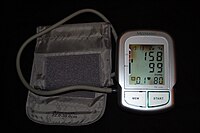
Photo from wikipedia
Supplemental Digital Content is available in the text Objective: The excess risk of atrial fibrillation in relation to the presence of proteinuria associated with hypertension has not been well elucidated.… Click to show full abstract
Supplemental Digital Content is available in the text Objective: The excess risk of atrial fibrillation in relation to the presence of proteinuria associated with hypertension has not been well elucidated. We aimed to determine the effect of hypertension and/or proteinuria on the incidence of atrial fibrillation. Second, we evaluated whether the associations with temporal changes in proteinuria status on the incidence of atrial fibrillation. Methods and results: A total of 85 434 participants with hypertension and 125 912 participants without hypertension with age at least 60 years from the Korea National Health Insurance Service-Senior cohort were included. Amongst controls (participants without proteinuria and hypertension), hypertension only, proteinuria only, and hypertension with proteinuria groups, the adjusted incidences of atrial fibrillation were 0.51, 0.69. 0.78 and 0.99 per 100 person-years, respectively after inverse probability of treatment weighting. Compared with controls, the weighted risks of atrial fibrillation in the hypertension only, proteinuria only and hypertension with proteinuria groups were increased by 37% (hazard ratio 1.37, 95% confidence interval, CI 1.30–1.44, P = 0.001), 55% (hazard ratio 1.55, 95% CI 1.28–1.88, P < 0.001), and 98% (hazard ratio 1.98, 95% CI 1.62–2.43, P < 0.001), respectively. Populations who had proteinuria in the first examination had an increased risk of atrial fibrillation even in the group whereby the proteinuria was resolved on the second examination (hazard ratio 1.36, 95% CI 1.12–2.31, P < 0.001). The presence of proteinuria in first and second analysis had the highest risk of incident atrial fibrillation (hazard ratio 1.61, 95% CI 1.12–2.31). Conclusion: In conclusion, hypertension and/or proteinuria were associated with increased risk of atrial fibrillation, with the greatest risks when both are present. Proteinuria could be a useful factor for predicting atrial fibrillation development.
Journal Title: Journal of Hypertension
Year Published: 2022
Link to full text (if available)
Share on Social Media: Sign Up to like & get
recommendations!